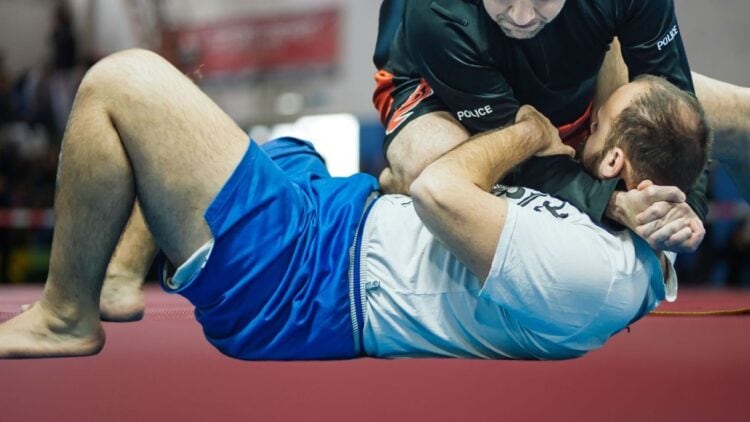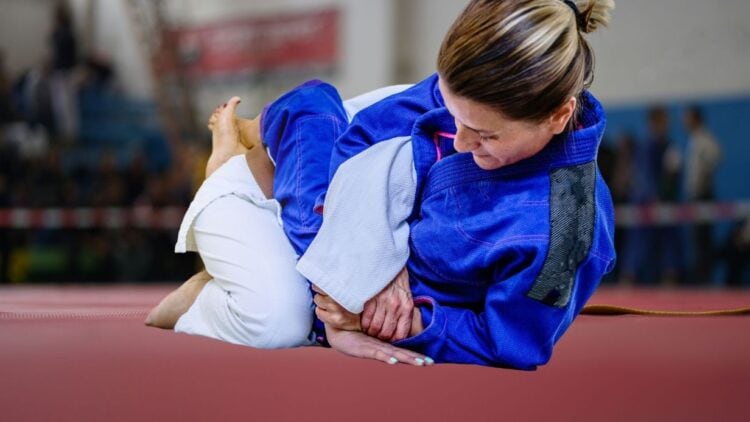
OBJECTIVE OF BRAZILIAN JUJUTSU: Successfully submit the opponent or accumulate the most points throughout the match.
NUMBER OF PLAYERS: 2 players
MATERIALS: Proper clothing, mouthguard
TYPE OF GAME: Sport
AUDIENCE: 3+
OVERVIEW OF BRAZILIAN JUJUTSU
Brazilian jujutsu (BJJ), often spelled “Brazilian jiujitsu”, is a martial art focusing on ground fighting techniques. The skills and techniques used in this combat sport are designed so that a person can take down any opponent, regardless of how much bigger or stronger they are.
BJJ was developed by the Gracie family after learning judo at the instruction of Mitsuyo Maeda. One of the family’s younger members, Carlos, started focusing all of his efforts on ground fighting, as he was too small at the time to reliably use the throwing techniques that are pivotal to judo. As a result, Brazilian jujutsu was born.
Although Carlos’s reasoning for developing BJJ was that he was too small for most judo techniques, this is a misrepresentation of the sport. This is because judo techniques—including the throws that are a large part of its identity—are designed specifically to be used on opponents of any size. Therefore, the idea that BJJ is the “small man’s judo” is misleading, as both combat styles are quite similar in that regard.
The main difference between BJJ and judo is that one focuses on standing techniques (judo) while the other is almost entirely centered around ground fighting skills (BJJ). It’s worth noting that although judo and BJJ have shared roots and techniques, these are two separate martial arts with distinct training methodologies, strategies, and points of emphasis.
Regardless of why BJJ came to fruition, one thing is certain: it is massively more popular in the West than judo. The main reason is that in the 1970s, the Gracie family moved to the United States and brought the sport with them. Rorion Gracie also co-founded the Ultimate Fighting Championship (UFC) in 1993, an organization that hosts arguably the most popularized and glamorized fighting events in the world. A major pillar of these UFC events is, of course, the use of BJJ ground fighting techniques.
SETUP

EQUIPMENT
- Proper clothing: BJJ traditionally requires fighters to wear a gi, which is a robe-like uniform used in most other Japanese-derived martial arts. However, “no-gi” competitions are becoming more prominent. In the case of these events, fighters often wear casual MMA attire, such as MMA shorts and a rashguard shirt.
- Mouthguard: Fighters should wear a mouthguard to prevent any unnecessary injuries from occurring.
MATCH FORMAT
Competitive BJJ matches pit two fighters of the same weight class against each other in five- to ten-minute matches. The level (belt color) of the fighters determines the length of the match. The lowest-level fighters (white belts) only have matches that are five minutes long, while the top fighters (black belts) generally have ten-minute bouts. That said, in certain high-level competitions between black belts, matches may only last five minutes.
BJJ RANKING SYSTEM
As with many other martial arts, BJJ uses a belt ranking system. The belt colors represent an athlete’s level of expertise and experience with the martial art, indicating different skill levels. As students improve and progress, they can move up the rankings and earn the different colored belts.
Here is the BJJ ranking system:
- White
- Blue
- Purple
- Brown
- Black
Beyond the black belt, some BJJ organizations have additional degrees or stripes on black belts to further recognize a practitioner’s experience and contributions to the art.
GAMEPLAY

BJJ PRINCIPLES
As previously mentioned, Brazilian jujutsu primarily focuses on ground fighting techniques that allow a smaller individual to control a larger opponent. In order to make this happen, BJJ techniques are centered around using a fighter’s weight distribution and leverage to their advantage while subsequently minimizing their opponent’s ability to do the same. Since kicks, punches, and all other types of strikes aren’t allowed, all of this control must be achieved through grappling techniques.
Because you can use BJJ against seemingly any opponent, most people consider it the gold standard of self-defense training.
SCORING
The primary objective of a BJJ match is to submit the opponent by forcing them to tap out. The most common way to do this is through the use of joint locks and chokes. If an opponent is successful in the submission, the match immediately ends, and the player that scored the submission wins.
If no submission occurs, the fighter with the most points at the end of the match wins. There are a number of ways to score points in Brazilian jujutsu:
- Takedown (2 points) – Bring a standing opponent to the ground.
- Sweep (2 points) – Switch places with an opponent who is on top and maintain that new top control position for at least three seconds.
- Knee-on-belly (2 points) – A side control position in which a fighter places their knee on their opponent’s stomach on the ground. The fighter must maintain this position for at least three seconds to score these points.
- Guard passing (3 points) – Any move in which a fighter can get past their opponent’s guard position, such as swiping their knees out of the way when they’re being used to keep distance between the two fighters.
- Full mount (4 points) – A position in which a fighter is able to lay directly on top of their opponent’s torso. The fighter must hold this position for three seconds for points to gain 4 points.
- Back mount (4 points) – The same as a normal full mount, except the fighter on the bottom is lying on their stomach. This must also be held for three seconds.
In addition to the points fighters can score for successfully using the above techniques, fighters can also gain “advantage points”. These advantage points are awarded for moves that almost result in normal points, such as only holding a position for two seconds instead of three. In some competitions, advantage points are used to determine a winner if the score is tied at the end of a match.
However, a single point is worth more than any amount of advantage points, meaning that ten advantage points awarded from almost performing ten successful sweeps are worth less than a single successful sweep.
PENALTIES
In competitions, referees give out penalties to discourage certain behaviors or actions that are considered illegal or against the rules. Here are some common penalties that referees may enforce during BJJ matches:
- Stalling
- Guard pulling
- Illegal techniques
- Unauthorized gripping of the opponent’s uniform
- Unsportsmanlike conduct
- Eye poking
The severity of penalties can vary based on the competition and the referee. But as a general rule, penalties result in advantages awarded to the opponent, points deduction, or, in severe cases, disqualification. Repeated penalties may also lead to disqualification.
END OF GAME
The winner is the fighter who successfully submits their opponent or accumulates the most points by the end of the match.
In the event of a tie, in some competitions, the fighter with more advantage points wins! In the case that the advantage points are tied as well, the penalties may determine the outcome of the match.
- 30 GAMES TO PLAY OVER TEXT - April 22, 2024
- 20+ FREE PRINTABLE BABY SHOWER GAMES - April 16, 2024
- 20+ College Party Games for the Best Night Ever! - April 2, 2024